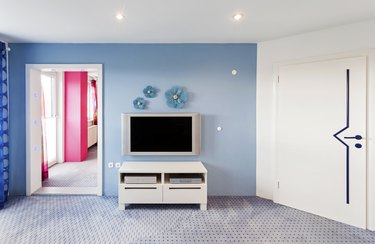
The TV -- especially flat-screens -- has moved from the entertainment stand to the wall, and it may be affecting your viewing experience. A dark-colored or wood-grain entertainment stand, for example, offered an ideal television "house," optimizing screen visibility by reducing glare. Whether you're a daily watcher or just enjoy the occasional movie or a few weekly shows, improve your television time with the right backdrop color on the wall.
Why Dull and Dark Works
Video of the Day
Dark walls -- charcoal, theater-curtain navy blue, flat-screen black -- practically disappear because of their lack of vibrancy. A dark backdrop causes little visual disturbance or distraction, which helps you keep your eyes on the screen. Other than color, however, sheen is important. Opt for flat paint or shine-free wallpaper, such as natural grass cloth, that won't bounce disturbing light from windows, light bulbs or the screen's brightness.
Video of the Day
Put the TV on Mute
If dark shades seem dungeon-like, you might prefer a muted or toned-down color behind your flat-screen TV. Muted hues are the "wallflowers" in a palette. Their hazy, barely-a-color effect makes them seem to drop away, allowing the TV's picture to become more focal or visually pronounced. In a media room or living room, a wall color, such as umber, mid-brown, sage, steel blue or gray, won't "steal the show."
Painted Into the Wall
If your flat-screen TV's presence is about as welcome as a dental chair, use color trickery to integrate it cunningly into the room. Paint the walls tan, white or pale gray. Using painter's tape, create an even band around the room or just on the wall behind the television. The band should run at least a few inches below and above the TV. Fill in the taped outline with black paint to contrast with the neutral-colored upper and lower areas, and blend it with a black television, almost hiding it in direct sight. Alternatively, group the rectangular TV among artwork -- black frames or black-and-white art or photos make a black component less noticeable.
Bright Done Right
If you must have bright color on the wall behind your TV, contemplate using curtains to hide the hue, as needed. You can stack back dark- or muted-colored curtains that run the wall's length when the television is turned off, and then pull them closed for better screen visibility when it's on. Or, hang the curtains from the ceiling just in front of the TV to keep the component from offending the design when it's not in use. The curtain's softness and density also act as a sound muffler, absorbing any echo created by the volume or a surround-sound system. Paint the ceiling black to highlight a bright wall and reduce reflection off a white ceiling onto the screen.